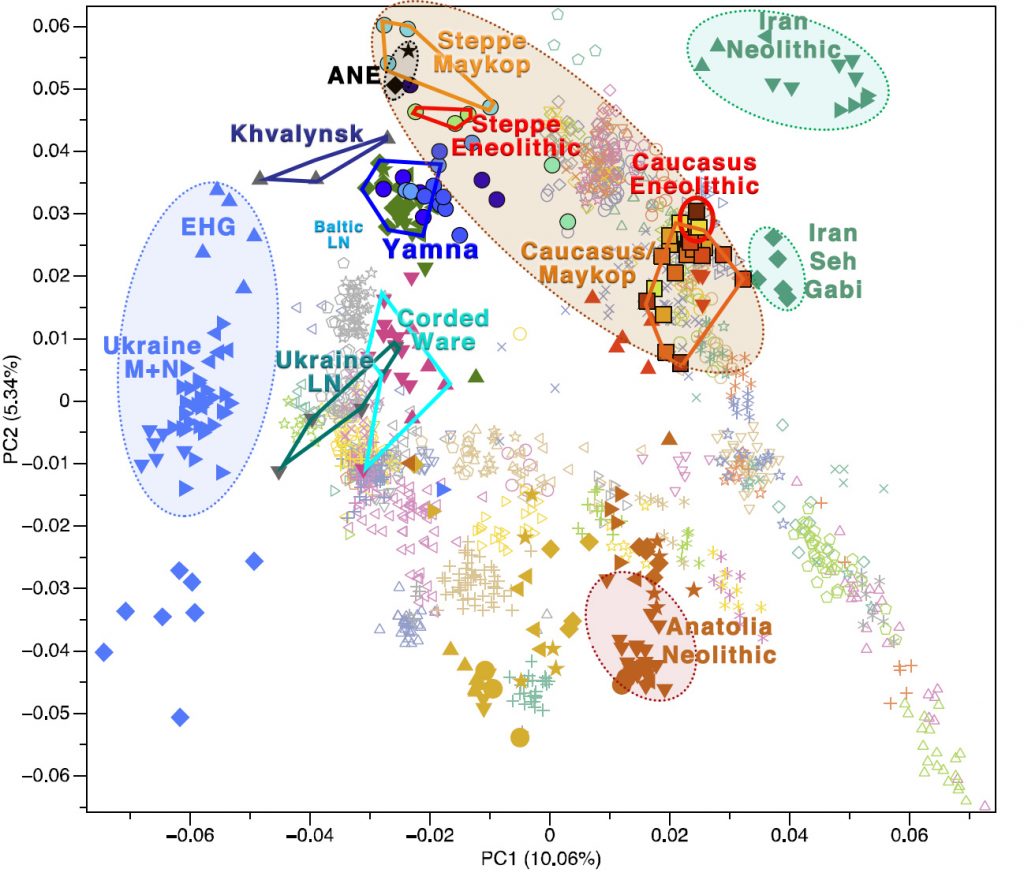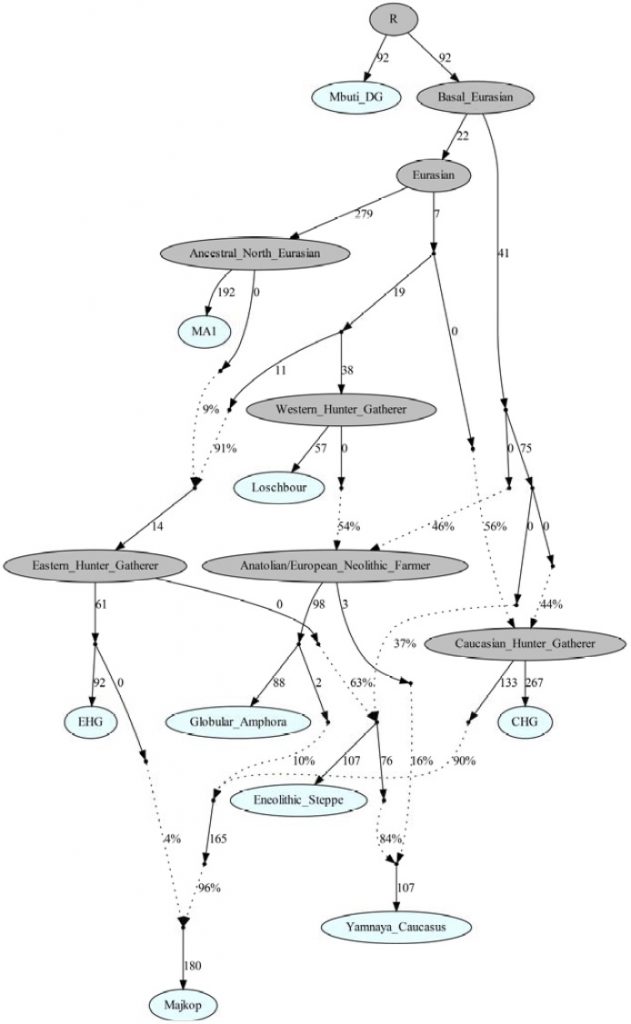Some interesting excerpts from Wang et al. (2018):
An interesting observation is that steppe zone individuals directly north of the Caucasus (Eneolithic Samara and Eneolithic steppe) had initially not received any gene flow from Anatolian farmers. Instead, the ancestry profile in Eneolithic steppe individuals shows an even mixture of EHG and CHG ancestry, which argues for an effective cultural and genetic border between the contemporaneous Eneolithic populations in the North Caucasus, notably Steppe and Caucasus. Due to the temporal limitations of our dataset, we currently cannot determine whether this ancestry is stemming from an existing natural genetic gradient running from EHG far to the north to CHG/Iran in the south or whether this is the result of farmers with Iranian farmer/ CHG-related ancestry reaching the steppe zone independent of and prior to a stream of Anatolian farmer-like ancestry, where they mixed with local hunter-gatherers that carried only EHG ancestry.

Concerning the influences from the south, our oldest dates from the immediate Maykop predecessors Darkveti-Meshoko (Eneolithic Caucasus) indicate that the Caucasus genetic profile was present north of the range ~6500 BP, 4500 calBCE. This is in accordance with the Neolithization of the Caucasus, which had started in the flood plains of the great rivers in the South Caucasus in the 6th millennium BCE from where it spread to the West and Northwest Caucasus during the 5th millennium BCE9, 49. It remains unclear whether the local CHG ancestry profile (represented by Late Upper Palaeolithic/Mesolithic individuals from Kotias Klde and Satsurblia in today’s Georgia) was also present in the North Caucasus region before the Neolithic. However, if we take the Caucasus hunter-gatherer individuals from Georgia as a local baseline and the oldest Eneolithic Caucasus individuals from our transect as a proxy for the local Late Neolithic ancestry, we notice a substantial increase in Anatolian farmer-related ancestry. This in all likelihood is linked to the process of Neolithization, which also brought this type of ancestry to Europe. As a consequence, it is possible that Neolithic groups could have reached the northern flanks of the Caucasus earlier50 (Supplementary Information 1) and in contact with local hunter gatherers facilitated the exploration of the steppe environment for pastoralist economies. Hence, additional sampling from older individuals is needed to fill this temporal and spatial gap.
The newest paper of the Reich/Jena group has brought samples (probably) much nearer to the actual CHG and ANE contribution seen in Eneolithic steppe peoples than the previously available Kotias Klde, Satsurblia, Afontova Gora 3, or Mal’ta.
It is impossible to say without direct access to the samples, but it is very likely that we will soon be able to break down different gross contributions from groups similar to these Steppe/Caucasus Neolithic ancestral groups into the diverse Eneolithic cultures of the Pontic-Caspian steppe, and thus trace more precisely each of these cultures to their genetic (and thus ethnolinguistic) heirs.

Some more representative samples from Eneolithic steppe, steppe-forest and forest zone cultures of Eastern Europe will probably help with the fine-scale structure of different Chalcolithic groups, especially the homeland of early Corded Ware groups.
These new samples seem another good reason (like the Botai and R1b-M73) to rethink the role of (what I assumed were) different westward Mesolithic Eurasian waves of expansion influencing the formation of an Indo-Uralic and Indo-European community in Eastern Europe, and return to the simpler idea of local contributions from North Caucasus and steppe peoples absorbed by expanding EHG-like groups.
Related:
- The Caucasus a genetic and cultural barrier; Yamna dominated by R1b-M269; Yamna settlers in Hungary cluster with Yamna
- Consequences of Damgaard et al. 2018 (I): EHG ancestry in Maykop samples, and the potential Anatolian expansion routes
- On the potential origin of Caucasus hunter-gatherer ancestry in Eneolithic steppe cultures
- Eneolithic Ukraine cultures of the North Pontic steppe and southern steppe-forest, on the Left Bank of the Dnieper
- North Pontic steppe Eneolithic cultures, and an alternative Indo-Slavonic model
- Consequences of Damgaard et al. 2018 (III): Proto-Finno-Ugric & Proto-Indo-Iranian in the North Caspian region
- No large-scale steppe migration into Anatolia; early Yamna migrations and MLBA brought LPIE dialects in Asia
- Lazaridis’ evolutionary history of human populations in Europe
- The renewed ‘Kurgan model’ of Kristian Kristiansen and the Danish school: “The Indo-European Corded Ware Theory”